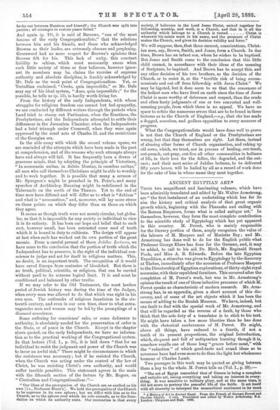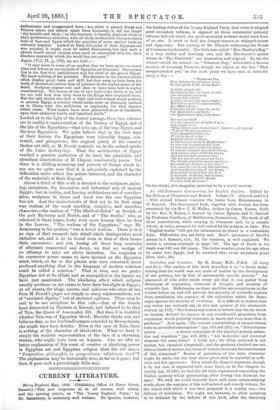ANCIENT EGYPTIAN ART.*
THESE two magnificent and fascinating volumes, which have been admirably translated and edited by Mr. Walter Armstrong, are "the first instalment of an undertaking which has for its aim the history and critical analysis of that great organic
growth which, beginning with the Pharaohs and ending with the Roman Emperors, forms what is called antique art." In themselves, however, they form the most complete contribution to the scientific study of Egyptology which has yet appeared in this country. M. Perrot, who is mainly responsible for the literary portion of them, amply recognises the value of the labours of M. Maspero and of Marlette Bey ; and Mr. Armstrong has done well to do for the English public what Professor George Ebers has done for the German, and, it may be added, to call to his aid Dr. Birch, Mr. Reginald Stuart- Poole, and Miss A. B. Edwards. Before the late Egyptian Expedition, a stimulus was given to Egyptology by the discovery at Thebes, immediately after the accession of Professor Ma.spere to the Directorship of Egyptian explorations, of thirty-eight royal mummies, with their sepulchral furniture. This occurred after the completion of M. Perrot's work, but was in Mr. Armstrong's opinion the result of one of those inductive processes of which M. Perrot speaks as characteristic of modern research. Mr. Arm- strong has, in an appendix, given a short account of this dis- covery, and of some of the art objects which it has been the means of adding to the Boulalc Museum. We have, indeed, but one fault to find with the special work of Mr. Armstrong, and that will be regarded as the reverse of a fault, by those who think that the sole duty of a translator is to stick to his text.
He might have taken a few more liberties than he has done with the rhetorical .exuberances of M. Perrot. He might, above all things, have reduced to a fourth, if not a tenth of its present proportions, the original Introduction, which, eloquent and fall of antiquarian learning though it is, somehow recalls one of those long "graces before meat," with the " reduction " of which good-taste and sound ideas as to reverence have had even more to do than the light but wholesome humour of Charles Lamb.
Two passages in this work may be quoted as giving between them a key to the whole. M. Perrot tells us (Vol. I., p. 38) :—
" The art of Egypt resembled that of Greece in being a complete and catholic art, seeing everything and taking an interest in every- thing. It was sensitive to military glory, and at the same time, it did not scorn to portray the peaceful life of the fields. It set itself with all sincerity to interpret the monarchical sentiment in its most • A History of Art in Ancient Egypt. From the French. of Georges Perrot and Charles Chipiez. 2 vols. Translated and edited by Walter Armstrong, B.A. London : Chspman and Hall. 1883.
enthusiastic and exaggerated form ; but while it placed Kings and Princes above and almost apart from humanity, it did not forget
the humble and meek ;' on the contrary, it frankly depicted them in their professional attitudes, with all those ineffaceable characteristics both of face and figure which the practice of some special trade so certainly imparts. Looked at from this point of view, Egyptian art was popular, it might even be called democratic, but that such a phrase would sound carious when used in connection with the most absolute monarchy which the world has yet seen."
Again (Vol. II., p. 176), we are told :— "It may seem to some of our readers that we have spent too much time and labour on our analysis of Egyptian architecture. Our excuse lies in the fact that architecture was the chief of the arts in Egypt. We know nothing of her painters. The pictures in the Theban tombs often display great taste and skill, but they seem to have been the work of decorators, rather than of painters in the higher sense of the word. Sculptors appear now and then to have been held in higher consideration. The names of one or two have come down to us, and we are told bow dear they were to the Kings who employed them. But the only artists who had a high and well-defined social position in ancient Egypt, a country where ranks were as distinctly marked as in China, were the architects or engineers, for they deserve either name. Their names have been preserved to us in hundreds, upon their elaborate tombs and inscribed shells."
Looked at in the light of the former passage, these two volumes are in reality a representation of the history of Egypt, and of the life of the Egyptians,—that is to say, of the true Egypt, and the true Egyptians. We quite believe that in the best days of their history the Egyptians were tolerably happy, con- tented, and prosperous ; the original gaiety of the country flashes out still, as M. Perrot reminds us, in the animal spirits of the Cairo donkey-boy. That the architecture of Egypt reached a genuine perfection of its kind, the admirable and abundant illustrations of M. Chipiez conclusively prove. Yet there is a chilling monotony and poverty of design about it ; nor are we quite sure that it is adequately explained by the 41ifficulties under which the artists laboured, and the character of the materials at their disposal.
About a third of this work is devoted to the sculpture, paint- ing, caricature, the decorative, and industrial arts of ancient Egypt ; but in reality, and leaving architecture out of consider- ation, sculpture in stone and wood was the one Egyptian fine art. And, the characteristic of that art in its first stage was realism of the most startling, complete, and merciless character,—the realism of "The Sheik-el-Beled " at Boulak, of the pair Ra-hotep and Nefert, and of "The Scribe," who, as coloured in these pages, looks even more human than he does in the Louvre. "The realism of the Egyptians," says Mr. Armstrong in his preface, "was a broad realism. There is in it no sign of that research into detail which distinguishes most imitative art, and is to be found even in that of their imme- diate successors ; and yet, during all those long centuries of alternate renascence and decay, we find no vestige of an attempt to raise art above imitation. No suspicion of its expressive power seems to have dawned on the Egyptian mind, which, so far as the plastic arts were concerned, never produced anything that in the language of modern criticism could be called a creation." That is true, and we prefer
Egyptian Art at its oldest, and as exemplified in the figures we have just mentioned. The idealising effect which religion usually produces on art seems to have been but slight in Egypt ; at all events, the kings, queens, and sphinxes who stare at one from M. Perrot's pages are simply so many representations, not of "anointed dignity," but of anointed ugliness. There may be said to be one exception to this rule,—that of the female head discovered by Ilariette at Karnak, and believed to be that of Taia, the Queen of Amenophis III. But then it is doubtful whether Taia was of Egyptian blood ; Marlette thinks not, and believes that, as her husband's empire extended to Mesopotamia, she might have been Asiatic. Even in the case of Taia, there is nothing of the character of idealisation. What we have is simply the realistic representation of the face of a charming woman, who might have been an Aspasia. Can we offer no
better explanation of this want of creative or idealising power
in Egyptian art and Egyptian religion than the old one,— " Paupertina philosophia in paupertinam religionem du,eit"P The explanation may be historically true, so far as it goes ; but
then, it goes such a provokingly little way.



































 Previous page
Previous page